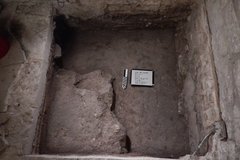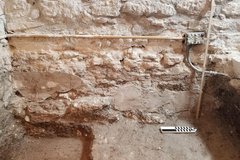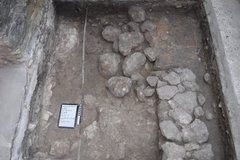Archaeological excavations continued in the units that had been opened the previous week associated with the Long Barrack. The excavation unit located inside the southern portion of the Long Barrack continued to expose more of the south and west walls of the structure. These explorations are providing valuable information to the historic architects about the construction and alterations to the walls.
Alamo Archaeology Update — Modern Concrete Feature Discovered in Long Barrack
A compact caliche surface was identified in the northeast corner of the unit inside of the Long Barrack. At this time, it is unknown if the caliche is associated with construction or represents one of the living surfaces inside the structure, but excavations continuing next week will hopefully shed light on the purpose of the caliche surface.
Cultural material recovered from the unit continues to exhibit mixed context, with clear glass, wire nails, and white earthenwares in the same level as lead glazed ceramics, square nails, and olive glass.

Removal of the soils from the west wall of the Long Barrack has revealed evidence a concrete veneer on the stones. The concrete is a more modern treatment to the Long Barrack and indicates that the area closest to the wall had soil removed to allow for the application.

The one unit placed on the exterior of the arcade of the Long Barrack encountered a linear feature in the eastern portion of the unit. The alignment of limestone spans the eastern portion of the unit, running north-south, but exhibits two different construction methods.
The southern part of the alignment consists of stacked, rough limestone with voids between the stones. Although fragments of mortar were noted in the soils, there does not appear to be evidence of mortar connecting the stones. The northern portion of the alignment consisted of cut limestone exhibiting chisel marks.
On top of the limestone is a compact sandy matrix that may be a type of mortar. Dr. Steve Tomka, lead Archaeologist from Raba Kistner Environmental, believes that the cut limestone portion of the feature may be related to the second story porch supports noted in the historic pictures of the Hugo-Schmeltzer interior courtyard.

Similar to the previous week, artifacts recovered during the excavations are dating to all periods of the occupation of the site. Colonial ceramics and glass are observed in the same level as 19th and 20th century objects.
It is possible that the mixture of artifact time periods is occurring due to the proximity of the units to walls that have been fixed or altered since their original construction during the mission period. Excavations will continue in these units into next week.


